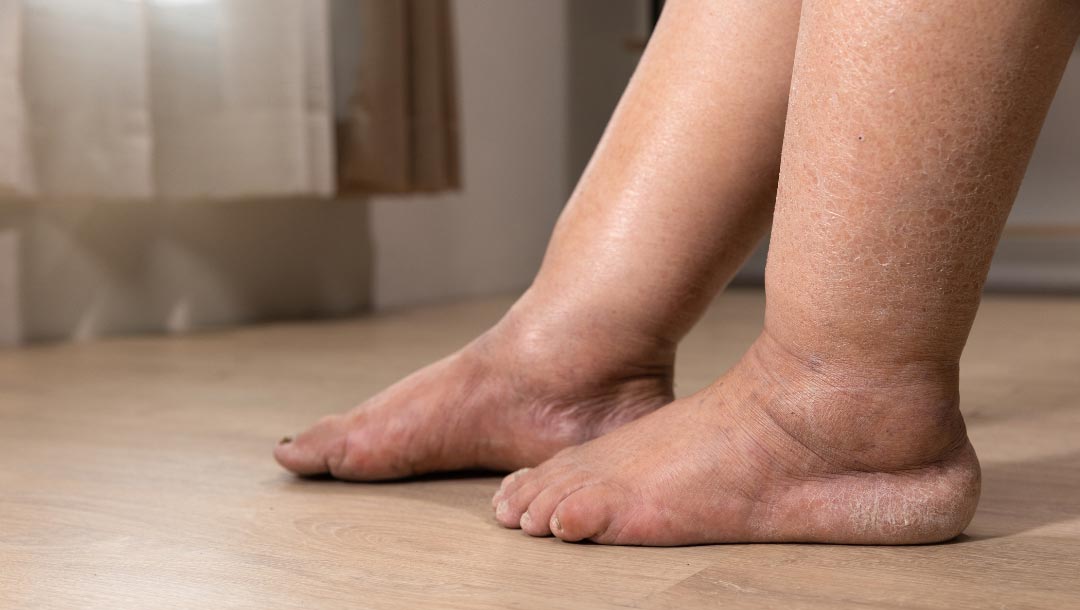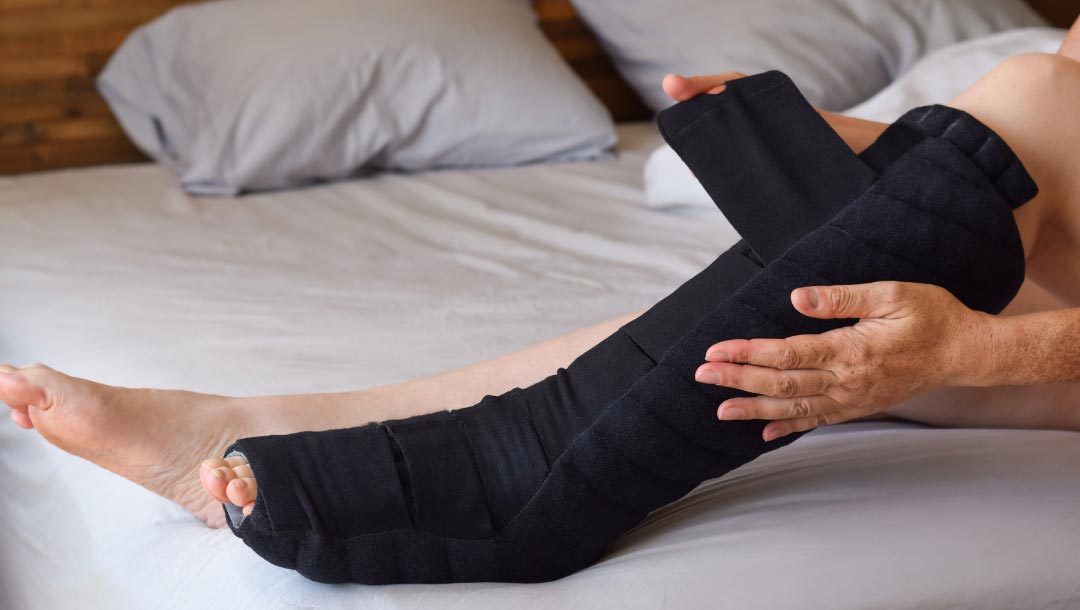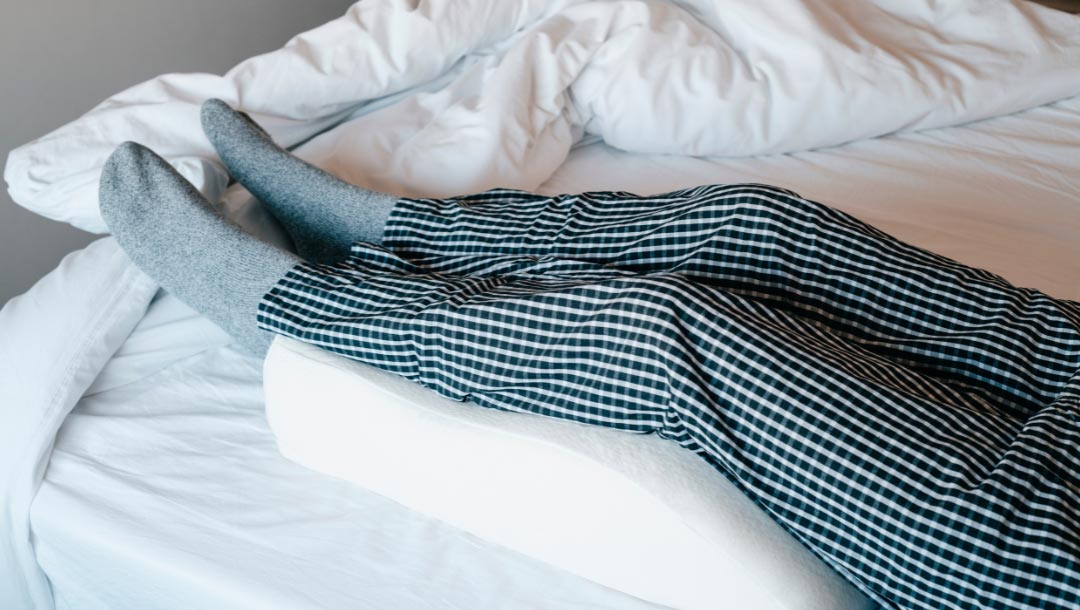What is lymphoedema?
Lymphoedema is a chronic (long-lasting) condition that leads to swelling in certain parts of the body, most commonly the arms or legs. This swelling happens when the lymphatic system, which plays a key role in fighting infection and draining excess fluid (lymph), doesn’t work properly. Instead of draining lymph fluid away, the system becomes blocked or damaged, leading to a build-up of fluid in the tissues. Over time, this can lead to discomfort, difficulty moving the affected limb, and changes in the skin.
While there is no cure for lymphoedema, it can be managed effectively with the right treatment and lifestyle adjustments. Early diagnosis and proper care can help reduce symptoms and prevent complications.
How lymphoedema develops
The lymphatic system is a network of vessels and glands spread throughout your body, similar to the blood circulation system. It carries a clear fluid called lymph, which helps remove waste, toxins, and unwanted materials. When this system becomes blocked or damaged, it can no longer drain fluid effectively. This leads to a build-up of fluid in the tissues, causing swelling and other symptoms.
Lymphoedema can be primary (caused by inherited problems with the lymphatic system) or secondary (caused by damage to the lymphatic system from an injury, surgery, or illness).
Who is affected?
Lymphoedema can affect anyone, but some people are more likely to develop it than others. Knowing your risk factors helps with early diagnosis and management.
You may be at higher risk if you:
- Have had cancer treatments that involved lymph node removal or radiotherapy, particularly for breast, pelvic, or prostate cancer
- Are overweight as this increases pressure on the lymphatic system
- Are an older adult, the lymphatic system weakens with age
- Have had trauma, surgery, or existing vein problems affecting your limbs
- Were born with a poorly developed lymphatic system (known as primary lymphoedema), which may cause symptoms at birth, during puberty, or later in life
Lymphoedema can be a lifelong condition, so it’s important to recognise the signs early and seek medical advice to avoid long-term complications.
Signs and symptoms of lymphoedema
Common signs and symptoms
The main symptom of lymphoedema is swelling, often in an arm or leg, but it can also occur in the chest, abdomen, or face. This swelling might start off mild and come and go, but without treatment, it can become more persistent and severe.
You might also notice:
- A heavy or tight feeling in the affected area
- Discomfort, aching, or a feeling of fullness
- Difficulty moving the joint near the swelling (like the ankle or wrist)
- Skin changes such as thickening, hardening, or dryness
- Clothes or jewellery feeling tighter than usual
- Repeated skin infections such as cellulitis
Understanding what to look out for helps you feel more in control and confident in managing your health.

When symptoms may worsen
Lymphoedema symptoms can vary from day to day. They often get worse in hot weather, after long periods of standing or sitting still, or after strenuous activity.
The swelling can also increase during air travel or if you’ve had an infection in the affected area. Without regular treatment and care, the build-up of fluid can lead to changes in the skin and tissue that are hard to reverse.
Causes and risk factors of lymphoedema
Common causes
Lymphoedema occurs when the lymphatic system is unable to drain lymph fluid properly. The common causes for this are:
- Cancer treatments: Procedures like radiotherapy or surgery that involve lymph node removal can disrupt lymph flow and increase the risk of swelling in nearby areas.
- Infection: Repeated infections, such as cellulitis, can cause inflammation and scarring in the lymphatic vessels, reducing their ability to drain fluid.
- Injury: Trauma or injury such as deep cuts, burns, or even severe bruising can damage lymph vessels and block fluid drainage.
- Surgery: Especially operations involving veins or lymph nodes, such as vein stripping, lymph node dissection, or vascular bypass procedures. These can disrupt lymphatic pathways, leading to a build-up of fluid.
- Congenital conditions: Some people are born with fewer or underdeveloped lymph vessels (known as primary lymphoedema), which can lead to symptoms from birth or later in life.
- Idiopathic lymphoedema: For some patients, the development of swelling in arms and legs can occur without an underlying cause or without an identifiable reason.
Risk factors you should know
Certain factors make you more likely to develop lymphoedema. These include both medical history and lifestyle factors:
- A personal or family history of cancer involving lymph nodes: Treatments for cancer, such as surgery or radiotherapy, can disrupt lymph flow and increase the risk of swelling.
- Being overweight: Extra body weight increases the strain on lymph vessels, which can make it harder for fluid to drain effectively.
- Ageing: As we get older, the lymphatic system may become less efficient, raising the risk of lymph build-up, especially after surgery or infection.
- Venous conditions: Issues like varicose veins or deep vein thrombosis can impair circulation and place additional strain on the lymphatic system, making lymphoedema more likely.
How lymphoedema is diagnosed
Stages of lymphoedema
Lymphoedema progresses over time if left untreated. Healthcare professionals often describe it in four stages, from the earliest signs to more advanced symptoms:
- Stage 0 (Latent): There are no visible signs of swelling, but the lymphatic system is already not working properly. People in this stage may feel a sense of heaviness or tightness in the limb.
- Stage 1 (Mild): Swelling starts to appear but may come and go. It often reduces with rest and elevation of the limb. The skin is still soft, and there are no permanent changes to the tissue.
- Stage 2 (Moderate): Swelling becomes more persistent and doesn’t improve much with elevation. The skin may start to feel firmer or thicker, and there may be early signs of skin changes like dryness or slight hardening.
- Stage 3 (Severe): The swelling is severe and constant. The skin becomes hard, thickened, and possibly wart-like (a condition known as lymphostatic elephantiasis). There may be significant changes to the shape of the limb, and the risk of skin infections increases.
Clinical examination
A clinical examination is an important first step in diagnosing lymphoedema. Your healthcare provider will review your medical history, including any past surgeries or cancer treatments. They’ll check both limbs for size, shape, and skin condition, comparing any differences. The doctor may press on the skin to look for signs of fluid retention, assess for firmness, and ask about symptom changes over time. This examination helps identify whether the swelling is due to lymphoedema or another cause, guiding the need for further testing.
They may also ask about the timeline of your symptoms, what makes them better or worse, and whether you’ve experienced any infections or skin changes. This examination provides important clues that guide further testing or immediate treatment. They’ll also ask about how long the swelling has been present, if it’s painful, and whether it changes throughout the day.
Diagnostic tests
To confirm the diagnosis and rule out other causes of swelling, your doctor may use imaging tests such as:
- Lymphoscintigraphy: Uses a small amount of radioactive dye to track lymph fluid
- MRI or CT scan: Gives detailed images of the lymphatic and surrounding tissues
- Doppler ultrasound: Helps check blood flow and rule out clots in the veins
Treatment options for lymphoedema
Lymphoedema cannot be cured, but with the right treatment, symptoms can be managed effectively. Treatment is usually ongoing and tailored to each person’s needs.
Bandaging, compression wraps, leggings, or stockings
Compression is a key part of lymphoedema treatment. Specially designed wraps or stockings help apply pressure to the affected area to encourage lymph fluid to move out of the limb and prevent it from building up again. These need to be worn daily and fitted properly by a trained professional.

Manual lymphatic drainage
This is a specialised form of massage that helps move fluid through the lymphatic system. It should only be performed by a therapist trained in lymphoedema care. It’s often part of a treatment plan known as decongestive lymphatic therapy (DLT).
Compression pump
A compression pump is a device that inflates a sleeve placed over the limb. It delivers gentle pressure in cycles to help move lymph fluid. It’s often used at home in combination with other treatments.
Surgery and other treatments
For severe or advanced lymphoedema, surgery may be an option. Procedures can include removing excess tissue, improving lymphatic drainage, or transplanting lymph nodes. Liposuction may also be used in some cases to reduce the volume of the swollen area.
What to expect during and after lymphoedema treatment
Before your treatment
Before starting treatment, you’ll have an assessment with a lymphoedema specialist. This helps to understand your symptoms and choose the most suitable options.
You may be measured for compression garments and receive advice on how to care for your skin and reduce the risk of infection.
During your procedure
Most lymphoedema treatments are non-invasive and carried out on an outpatient basis, meaning you can usually return home the same day.
Depending on your care plan, this might include a session of manual lymphatic drainage with a specialist, fitting and instruction on how to use compression garments, or guidance on using a compression pump.
Your clinician will explain what each treatment involves, how it works, and what kind of results you can expect. They’ll ensure you’re comfortable and confident in using any equipment, particularly if you’ve been asked to continue therapy at home.
Aftercare and recovery
Effective aftercare plays a big role in managing lymphoedema long-term. You’ll be given detailed instructions on how to care for the affected area, including wearing compression garments daily, keeping the skin moisturised and protected, and avoiding anything that might cause injury or infection.
You may need to gradually build up activity levels and integrate gentle movement into your routine to support drainage. Some people also benefit from regular follow-up sessions with a lymphoedema specialist or physiotherapist. Monitoring your progress helps adjust your care plan and spot any early signs of complications.
When to resume normal activities
Many people with lymphoedema can continue with their usual routines, though some adjustments may be needed. Gentle exercises like walking, swimming, or stretching are encouraged as they support lymph flow. Avoid heavy lifting or tight clothing that can restrict circulation.
Follow-up appointments and long-term care
Lymphoedema needs lifelong management, so regular appointments are key. These help your healthcare team track your condition and adapt your treatment if needed. You might have annual reviews or more frequent visits depending on your symptoms but it’s important to actively manage your symptoms to prevent the condition getting worse.
Can lymphoedema be prevented?
Reducing your risks of developing lymphoedema
While it’s not always possible to prevent lymphoedema, particularly if you’ve had lymph nodes removed or damaged, there are evidence-based steps you can take to reduce your risk. These measures focus on protecting your lymphatic system, promoting healthy circulation, and avoiding triggers that can lead to swelling or complications:
- Protect your skin: Avoid cuts, burns, and insect bites, especially on areas at risk. Broken skin can lead to infections like cellulitis, which may worsen lymphatic damage.
- Maintain a healthy weight: Excess weight puts additional pressure on your lymphatic system and can make it harder for lymph fluid to move effectively.
- Stay active: Gentle movement supports circulation and lymphatic flow. Activities like walking and swimming are beneficial.
- Avoid tight-fitting clothes and jewellery: These can restrict lymph drainage and contribute to fluid build-up.w
- Follow clinical guidance after surgery or radiotherapy: If you're at increased risk, your healthcare provider may recommend wearing compression garments, attending physiotherapy, or monitoring for early signs of swelling.
By adopting these habits, especially after surgery or cancer treatment, you can support your lymphatic health and potentially delay or avoid the onset of lymphoedema.
Living with lymphoedema
Living with lymphoedema means adapting to a condition that requires consistent daily attention, but many people find that with the right routine, they can stay active and maintain a good quality of life.
Management is not just about reducing swelling but also about preserving skin health, staying mobile, and protecting emotional wellbeing. Support from healthcare professionals, friends, and community networks can make a meaningful difference.
Daily management tips
Building a self-care routine is vital. Key habits could include:
- Wearing compression garments every day to help prevent fluid build-up
- Elevating the affected limb throughout the day to encourage fluid drainage
- Doing simple, regular exercises to stimulate lymph movement
- Eating a balanced diet that supports vascular and skin health
- Drinking plenty of water to keep your body hydrated and your lymphatic system working efficiently

Skincare and infection prevention
Skin care is a vital part of managing lymphoedema because even small cuts or irritations can lead to infections that worsen swelling. The condition makes your skin more vulnerable, so maintaining its integrity is key to avoiding complications like cellulitis or fungal infections.
- Wash the affected area gently each day
- Use fragrance-free moisturisers to avoid skin cracks
- Treat small cuts or bites quickly
- Wear gloves for gardening or cleaning to avoid injury
Exercise and mobility
Physical activity supports lymph flow and keeps the muscles and joints in the affected area working well. Tailored movement routines can also help with weight management and overall wellbeing.
It’s best to focus on gentle, low-impact activities, and consider working with a physiotherapist to create a personalised exercise plan that suits your condition and abilities.
Emotional wellbeing and support
Living with lymphoedema doesn’t just affect your body, it can also take a toll on your mental and emotional health. It’s normal to feel anxious, frustrated, or isolated at times.
Support groups, counselling, and talking to others with similar experiences can make a real difference. If you're struggling to cope, speak to your GP or a mental health professional. Emotional wellbeing is just as important as physical health in managing a long-term condition like lymphoedema.
When to seek medical advice
Signs you shouldn’t ignore
You should contact your doctor if you notice any of the following:
- Sudden or severe swelling
- Redness, warmth, or pain in the limb
- Fever or chills
- Skin that breaks, changes colour, or develops sores
These could be signs of infection or other complications that need urgent treatment. The earlier you seek help, the easier it is to manage the problem and prevent serious issues.


